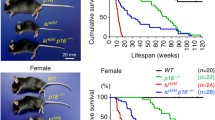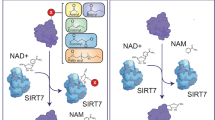Abstract
Klotho is an anti-aging protein with direct effects on life-span in mice. Klotho functions to regulate pathways classically associated with longevity including insulin/IGF1 and Wnt signaling. Decreased Klotho protein expression is observed throughout the body during the normal aging process. While increased methylation of the Klotho promoter is reported, other epigenetic mechanisms could contribute to age-related downregulation of Klotho expression, including microRNA-mediated regulation. Following in silico identification of potential microRNA binding sites within the Klotho 3′ untranslated region, reporter assays reveal regulation by microRNA-339, microRNA-556, and, to a lesser extent, microRNA-10 and microRNA-199. MicroRNA-339 and microRNA-556 were further found to directly decrease Klotho protein expression indicating that, if upregulated in aging tissue, these microRNA could play a role in age-related downregulation of Klotho messenger RNA. These microRNAs are differentially regulated in cancer cells compared to normal cells and may imply a role for microRNA-mediated regulation of Klotho in cancer.



Similar content being viewed by others
References
Azuma M, Koyama D, Kikuchi J, Yoshizawa H, Thasinas D, Shiizaki K, Kuro OM, Furukawa Y, Kusano E (2012) Promoter methylation confers kidney-specific expression of the Klotho gene. FASEB J. doi:10.1096/fj.12-211631
Boehm M, Slack FJ (2006) MicroRNA control of lifespan and metabolism. Cell Cycle 5(8):837–840
Brownstein CA, Adler F, Nelson-Williams C, Iijima J, Li P, Imura A, Nabeshima Y, Reyes-Mugica M, Carpenter TO, Lifton RP (2008) A translocation causing increased alpha-klotho level results in hypophosphatemic rickets and hyperparathyroidism. Proc Natl Acad Sci U S A 105(9):3455–3460. doi:10.1073/pnas.0712361105
Camilli TC, Xu M, O'Connell MP, Chien B, Frank BP, Subaran S, Indig FE, Morin PJ, Hewitt SM, Weeraratna AT (2010) Loss of Klotho during melanoma progression leads to increased filamin cleavage, increased Wnt5A expression, and enhanced melanoma cell motility. Pigment Cell Melanoma Res 24(1):175–186. doi:10.1111/j.1755-148X.2010.00792.x
Chang B, Kim J, Jeong D, Jeong Y, Jeon S, Jung SI, Yang Y, Kim KI, Lim JS, Kim C, Lee MS (2012) Klotho inhibits the capacity of cell migration and invasion in cervical cancer. Oncol Rep 28(3):1022–1028. doi:10.3892/or.2012.1865
Chen B, Wang X, Zhao W, Wu J (2010) Klotho inhibits growth and promotes apoptosis in human lung cancer cell line A549. J Exp Clin Cancer Res 29:99. doi:10.1186/1756-9966-29-99
Chen CD, Podvin S, Gillespie E, Leeman SE, Abraham CR (2007) Insulin stimulates the cleavage and release of the extracellular domain of Klotho by ADAM10 and ADAM17. Proc Natl Acad Sci U S A 104(50):19796–19801. doi:10.1073/pnas.0709805104
Cummins JM, He Y, Leary RJ, Pagliarini R, Diaz LA Jr, Sjoblom T, Barad O, Bentwich Z, Szafranska AE, Labourier E, Raymond CK, Roberts BS, Juhl H, Kinzler KW, Vogelstein B, Velculescu VE (2006) The colorectal microRNAome. Proc Natl Acad Sci U S A 103(10):3687–3692. doi:10.1073/pnas.0511155103
Duce JA, Podvin S, Hollander W, Kipling D, Rosene DL, Abraham CR (2008) Gene profile analysis implicates Klotho as an important contributor to aging changes in brain white matter of the rhesus monkey. Glia 56(1):106–117. doi:10.1002/glia.20593
ElSharawy A, Keller A, Flachsbart F, Wendschlag A, Jacobs G, Kefer N, Brefort T, Leidinger P, Backes C, Meese E, Schreiber S, Rosenstiel P, Franke A, Nebel A (2012) Genome-wide miRNA signatures of human longevity. Aging Cell 11(4):607–616. doi:10.1111/j.1474-9726.2012.00824.x
Griffiths-Jones S (2004) The microRNA Registry. Nucleic Acids Res 32(Database issue), D109-11. doi:10.1093/nar/gkh02332/suppl_1
Gui T, Zhou G, Sun Y, Shimokado A, Itoh S, Oikawa K, Muragaki Y (2012) MicroRNAs that target Ca(2+) transporters are involved in vascular smooth muscle cell calcification. Lab Invest 92(9):1250–1259. doi:10.1038/labinvest.2012.85
Ichikawa S, Imel EA, Kreiter ML, Yu X, Mackenzie DS, Sorenson AH, Goetz R, Mohammadi M, White KE, Econs MJ (2007) A homozygous missense mutation in human KLOTHO causes severe tumoral calcinosis. J Clin Invest 117(9):2684–2691. doi:10.1172/JCI31330
John B, Enright AJ, Aravin A, Tuschl T, Sander C, Marks DS (2004) Human microRNA targets. PLoS Biol 2(11):e363. doi:10.1371/journal.pbio.0020363
Kasashima K, Nakamura Y, Kozu T (2004) Altered expression profiles of microRNAs during TPA-induced differentiation of HL-60 cells. Biochem Biophys Res Commun 322(2):403–410. doi:10.1016/j.bbrc.2004.07
Kim J, Krichevsky A, Grad Y, Hayes GD, Kosik KS, Church GM, Ruvkun G (2004) Identification of many microRNAs that copurify with polyribosomes in mammalian neurons. Proc Natl Acad Sci U S A 101(1):360–365. doi:10.1073/pnas
Kim Y, Jeong SJ, Lee HS, Kim EJ, Song YR, Kim SG, Oh JE, Lee YK, Seo JW, Yoon JW, Koo JR, Kim HJ, Noh JW, Park SH (2008) Polymorphism in the promoter region of the klotho gene (G-395A) is associated with early dysfunction in vascular access in hemodialysis patients. Korean J Intern Med 23(4):201–207. doi:10.3904/kjim.2008.23.4.201
Kim Y, Kim JH, Nam YJ, Kong M, Kim YJ, Yu KH, Lee BC, Lee C (2006) Klotho is a genetic risk factor for ischemic stroke caused by cardioembolism in Korean females. Neurosci Lett 407(3):189–194. doi:10.1016/j.neulet.2006.08.039
King GD, Rosene DL, Abraham CR (2011) Promoter methylation and age-related downregulation of Klotho in rhesus monkey. Age (Dordr). doi:10.1007/s11357-011-9315-4
Kiriakidou M, Nelson PT, Kouranov A, Fitziev P, Bouyioukos C, Mourelatos Z, Hatzigeorgiou A (2004) A combined computational–experimental approach predicts human microRNA targets. Genes Dev 18(10):1165–1178. doi:10.1101/gad
Ko GJ, Lee EA, Jeon US, Pyo HJ, Chin HJ, Chae DW, Kim S, Kwon YJ (2012) The association of Klotho polymorphism with disease progression and mortality in IgA nephropathy. Kidney Blood Press Res 36(1):191–199. doi:10.1159/000343408
Kozomara A, Griffiths-Jones S (2011) miRBase: integrating microRNA annotation and deep-sequencing data. Nucleic Acids Res 39(Database issue), D152-7. doi: 10.1093/nar/gkq1027
Krek A, Grun D, Poy MN, Wolf R, Rosenberg L, Epstein EJ, MacMenamin P, da Piedade I, Gunsalus KC, Stoffel M, Rajewsky N (2005) Combinatorial microRNA target predictions. Nat Genet 37(5):495–500. doi:10.1038/ng1536
Kuro-o M (2009) Klotho and aging. Biochim Biophys Acta 1790(10):1049–1058. doi:10.1016/j.bbagen.2009.02.005
Kuro-o M, Matsumura Y, Aizawa H, Kawaguchi H, Suga T, Utsugi T, Ohyama Y, Kurabayashi M, Kaname T, Kume E, Iwasaki H, Iida A, Shiraki-Iida T, Nishikawa S, Nagai R, Nabeshima YI (1997) Mutation of the mouse klotho gene leads to a syndrome resembling ageing. Nature 390(6655):45–51. doi:10.1038/36285
Kurosu H, Yamamoto M, Clark JD, Pastor JV, Nandi A, Gurnani P, McGuinness OP, Chikuda H, Yamaguchi M, Kawaguchi H, Shimomura I, Takayama Y, Herz J, Kahn CR, Rosenblatt KP, Kuro-o M (2005) Suppression of aging in mice by the hormone Klotho. Science 309(5742):1829–1833. doi:10.1126/science.1112766
Landgraf P, Rusu M, Sheridan R, Sewer A, Iovino N, Aravin A, Pfeffer S, Rice A, Kamphorst AO, Landthaler M, Lin C, Socci ND, Hermida L, Fulci V, Chiaretti S, Foa R, Schliwka J, Fuchs U, Novosel A, Muller RU, Schermer B, Bissels U, Inman J, Phan Q, Chien M, Weir DB, Choksi R, De Vita G, Frezzetti D, Trompeter HI, Hornung V, Teng G, Hartmann G, Palkovits M, Di Lauro R, Wernet P, Macino G, Rogler CE, Nagle JW, Ju J, Papavasiliou FN, Benzing T, Lichter P, Tam W, Brownstein MJ, Bosio A, Borkhardt A, Russo JJ, Sander C, Zavolan M, Tuschl T (2007) A mammalian microRNA expression atlas based on small RNA library sequencing. Cell 129(7):1401–1414. doi:10.1016/j.cell.2007.04.040
Lee J, Jeong DJ, Kim J, Lee S, Park JH, Chang B, Jung SI, Yi L, Han Y, Yang Y, Kim KI, Lim JS, Yang I, Jeon S, Bae DH, Kim CJ, Lee MS (2010) The anti-aging gene KLOTHO is a novel target for epigenetic silencing in human cervical carcinoma. Mol Cancer 9(9):109. doi:10.1186/1476-4598-9-109
Lewis BP, Burge CB, Bartel DP (2005) Conserved seed pairing, often flanked by adenosines, indicates that thousands of human genes are microRNA targets. Cell 120(1):15–20. doi:10.1016/j.cell.2004.12.035
Matsumura Y, Aizawa H, Shiraki-Iida T, Nagai R, Kuro-o M, Nabeshima Y (1998) Identification of the human klotho gene and its two transcripts encoding membrane and secreted klotho protein. Biochem Biophys Res Commun 242(3):626–630
Maziere P, Enright AJ (2007) Prediction of microRNA targets. Drug Discov Today 12(11–12):452–458. doi:10.1016/j.drudis.2007.04.002
Nabeshima Y (2002) Ectopic calcification in Klotho mice. Clin Calcium 12(8):1114–1117
Nagai T, Yamada K, Kim HC, Kim YS, Noda Y, Imura A, Nabeshima Y, Nabeshima T (2003) Cognition impairment in the genetic model of aging klotho gene mutant mice: a role of oxidative stress. FASEB J 17(1):50–52. doi:10.1096/fj.02-0448
Shih PH, Yen GC (2007) Differential expressions of antioxidant status in aging rats: the role of transcriptional factor Nrf2 and MAPK signaling pathway. Biogerontology 8(2):71–80. doi:10.1007/s10522-006-9033-y
Stark MS, Tyagi S, Nancarrow DJ, Boyle GM, Cook AL, Whiteman DC, Parsons PG, Schmidt C, Sturm RA, Hayward NK (2010) Characterization of the melanoma miRNAome by deep sequencing. PLoS One 5(3):e9685. doi:10.1371/journal.pone.0009685
Stefani G, Slack FJ (2008) Small non-coding RNAs in animal development. Nat Rev Mol Cell Biol 9(3):219–230. doi:10.1038/nrm2347
Takahashi M, Eda A, Fukushima T, Hohjoh H (2012) Reduction of type IV collagen by upregulated miR-29 in normal elderly mouse and klotho-deficient, senescence-model mouse. PLoS One 7(11):e48974. doi:10.1371/journal.pone.0048974
Ueda R, Kohanbash G, Sasaki K, Fujita M, Zhu X, Kastenhuber ER, McDonald HA, Potter DM, Hamilton RL, Lotze MT, Khan SA, Sobol RW, Okada H (2009) Dicer-regulated microRNAs 222 and 339 promote resistance of cancer cells to cytotoxic T-lymphocytes by down-regulation of ICAM-1. Proc Natl Acad Sci U S A 106(26):10746–10751. doi:10.1073/pnas.0811817106
Wang L, Wang X, Jie P, Lu H, Zhang S, Lin X, Lam EK, Cui Y, Yu J, Jin H (2011) Klotho is silenced through promoter hypermethylation in gastric cancer. Am J Cancer Res 1(1):111–119
Weber MJ (2005) New human and mouse microRNA genes found by homology search. FEBS J 272(1):59–73. doi:10.1111/j.1432-1033.2004.04389.x
Witten D, Tibshirani R, Gu SG, Fire A, Lui WO (2010) Ultra-high throughput sequencing-based small RNA discovery and discrete statistical biomarker analysis in a collection of cervical tumours and matched controls. BMC Biol 8:58. doi:10.1186/1741-7007-8-58
Wolf I, Levanon-Cohen S, Bose S, Ligumsky H, Sredni B, Kanety H, Kuro-o M, Karlan B, Kaufman B, Koeffler HP, Rubinek T (2008) Klotho: a tumor suppressor and a modulator of the IGF-1 and FGF pathways in human breast cancer. Oncogene 27(56):7094–7105. doi:10.1038/onc.2008.292
Wu Q, Hwang CK, Zheng H, Wagley Y, Lin HY, Kim DK, Law PY, Loh HH, Wei LN (2012) MicroRNA 339 down-regulates mu-opioid receptor at the post-transcriptional level in response to opioid treatment. FASEB J. doi:10.1096/fj.12-213439
Wu ZS, Wu Q, Wang CQ, Wang XN, Wang Y, Zhao JJ, Mao SS, Zhang GH, Zhang N, Xu XC (2010) MiR-339-5p inhibits breast cancer cell migration and invasion in vitro and may be a potential biomarker for breast cancer prognosis. BMC Cancer 10:542. doi:10.1186/1471-2407-10-542
Acknowledgments
This work was funded by National Institutes of Health/National Institute on Aging R00 AG034989 (GDK).
Author information
Authors and Affiliations
Corresponding author
About this article
Cite this article
Mehi, S.J., Maltare, A., Abraham, C.R. et al. MicroRNA-339 and microRNA-556 regulate Klotho expression in vitro. AGE 36, 141–149 (2014). https://doi.org/10.1007/s11357-013-9555-6
Received:
Accepted:
Published:
Issue Date:
DOI: https://doi.org/10.1007/s11357-013-9555-6




